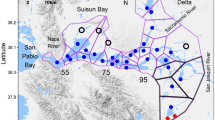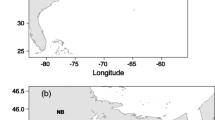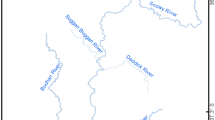Abstract
We have developed a simulation model to estimate pollution effects on economically important estuarine-dependent fish populations. Traditionally, pollution studies have focused upon impacts on individual organisms; however, wise management of marine resources depends upon an understanding of dynamics at the population level. As a required first step toward conducting relevant pollution studies, we have compiled available life history data on eight species (14 spatial-temporal stocks), concentrating on age-specific rates of growth, survival, and fecundity. Leslie matrix models of species population dynamics were used to predict pollutant impacts—mediate through changes in 1st-year survival. On average, and without compensation, these modelled stocks respond to a one-time-50% reduction in first-year survival by taking ten years to equilibrate at 88% of their preimpact abundance. Our synthesis of the data included a search for derived (standardized) population parameters to evaluate differences in susceptibility among and within fish populations to pollutant stresses. We demonstrated that knowledge of a species’ age-specific fecundity pattern provides additional predictive power of its response to pollution perturbation.
Similar content being viewed by others
Literature Cited
Carruthers, J. N. 1938. Flucations in the herrings of the East Anglian autumn fishery, the yield of the Ostend spent herring fishery, and the haddock of the North Sea—in the light of relevant wind conditions.Rapp. P.-v.-Reun. Cons. Perm. Int. Explor. Mer 107(3):10–15.
Cushing, D. H. 1969. The fluctuation of year classes and the regulation of fisheries.Fisheridir. Skr. Ser. Havunders. 15:368–379.
Demewtrius L. 1971. Primitivity conditions for growth matrices.Math. Boosci. 12:53–58.
Dietrich, C. S., Jr. 1979. Fecundity of Atlantic menhanden,Brevoortia tyrannus.Fish. Bull., U.S. 77:308–311.
Goodyear, C. P. 1985. Toxic materials, fishing and environmental variation: Simulated effects on striped bass population trends.Trans. Am. Fish. Soc. 114:107–113.
Hettler, W. F., andA. J. Chester. 1982. The relationship of winter temperature and spring landings of pink shrimp,Penaeus duorarum, in North Carolina.Fish. Bull., U.S. 80:761–768.
Higham, J. R., andW. R. Nicholson. 1964. Sexual maturation and spawning of Atlantic menhaden.Fish. Bull., U.S. 63: 255–271.
Horst, T. J. 1977. Effects of power station mortality on fish population stability in relationship to life history strategy, p. 297–310.In W. Van Winkle (ed.), Proc. Conferrence on Fish the Effects of Power-Plant Induced Mortality on Fish Populations. Pergamon Press, New York.
Ivo, C. T. C. 1972. Epoca de desova e idade na primeira maturucão sexual da cavala,Scomberomorous cavalla (Cuvier), no Estado do Ceara.Arq. Ciênc. Mar 12:27–29.
Ivo, C. T. C. 1974. Sobre a fecundidade da cavala,Scomberomorus cavalla (Cuvier), em aguas costerias do Estado do Ceará (Brasil).Arq. Ciênc. Mar 14:87–89.
Lefkovitch, L. P. 1969. Some comments on the invariants of population growth, p. 337–360.In G. P. Patil, E. C. Pielou, and W. E. Waters (eds.), Statistical Ecology, Vol. 3. Pennsylvania State University Press, University Park, Pa.
Leslie, P. H. 1945. On the use of matrices in certain population mathematics.Biometrika 33:183–212.
Lund, W. R., Jr., andG. C. Maltezos. 1970. Movements and migrations of the bluefish,Pomatomus saltatrix, tagged in waters of New York and southern New England.Trans. Am. Fish. Soc. 99:719–725.
Merriner, J. V. 1973. Assessment of the weakfish resource, a suggested management plan, and aspects of life history in North Carolina. Ph. D. Thesis, North Carolina State University, Raleigh. 201 p.
Merriner, J. V. 1976. Aspects of the reproductive biology of the weakfish,Cynoscion regalis (Sciaenidae), in North Carolina.Fish. Bull., U.S. 74:18–26.
Morse, W. W. 1981. Reproduction of the summer flounder,Paralichthys dentalus (L.).J. Fish. Biol. 19:189–203.
Nelson, W. R., M. C. Ingham, andW. E. Schaaf. 1977. Larval transport and year-class strength of Atlantic menhaden,Brevoortia tyrannus.Fish. Bull., U.S. 75:23–41.
O'Neill, R. V., R. H. Gardner, S. W. Chistensen, W. Van Winkle, J. H. Carney, andJ. B. Mankin. 1981. Some effects of parameter uncertainty in density-independent and densitydependent Lesile models for fish populations.Can. J. Fish. Aquat. Sci. 38:91–100.
Poole, J. C. 1961. Age and growth of the fluke in Great South Bay and their significance to the sport fishery.N.Y. Fish Game J. 8:1–18.
Radovich, J. 1962. Effects of sardine spawning stock size and environment on year-class production.Calif. Fish Game 48: 123–140.
Ricker, W. E. 1954. Stock and recruitment.J. Fish. Res. Board Can. 11:559–623.
Ricker, W. E. 1975. Computations and interpretation of biological statistics of fish populations.Bull. Fish. Res. Board Can. 191. 383 p.
Robson, D. S., andD. G. Chapman. 1961. Catch curves and mortality rates.Trans. Am. Fish. Soc. 90:181–189.
Rutherford, E., E. Thue, and D. Buker. 1982. Population characteristics, food habits and spawning activity of spotted seatrout,Cynoscion nebulosus, in Everglades National Park, Florida.U.S. Natl. Park Serv. S. Fla. Res. Cent. Rep. T-668. 48 p.
Saila, S. B., andE. Lorda. 1977. Sensitivity analysis applied to a matrix model of the Hudson River striped bass population, p. 311–332.In W. Van Winkle. (ed.), Proc. Conference on Assessing the Effects of Power-Plant-Induced Mortality on Fish Populations. Pergamon Press, New York.
Smith, R. W., andF. C. Daiber. 1977. Biology of the summer flounder,Paralichthys dentatus, in Delaware Bay.Fish. Bull., U.S. 75:823–830.
Smith, S. H. 1968. Species succession and fishery exploitation in the Great Lakes.J. Fish. Res. Board Gan. 25:667–693.
Sundararaj, B. I., andR. D. Suttkus. 1962. Fecundity of the spotted seatrout,Cynoscion nebulosus (Guvier), from Lake Borgne area, Louisiana.Trans. Am. Fish. Soc. 91:84–88.
Tabb, D. C. 1961. A contribution to the biology of the spotted seatroutCynoscion nebulosus (Cuvier) of east-central Florida.Fla. Board Conserv. Mar. Res. Lab. Tech. Ser. 35. 24 p.
Van Winkle, W. 1977. Assessing the Effects of Power-Plant-Induced Mortality on Fish Populations. Pergamon Press, New York. 380 p.
Vaughan, D. S., andW. van Winkle. 1982. Corrected analysis of the ability to detect reduction in year-class strength of the Hudson River white perch (Morone americana) populations.Can. J. Fish. Aquat. Sci. 39:782–785.
Walford, L. A. 1938. Effects of currents on distribution and survival of the eggs and larvae of the haddock (Melanogrammus aeglefinus) on Georges Bank.Fish. Bull., U.S. 49:1–73.
Wilk, S. J. 1977. Biological and fisheries data on bluefish,Pomatomus saltatrix (Linnaeus).U.S. Natl. Oceanic Atmos. Adm. Northeast Fish. Cent. Sandy Hook Lab. Tech. Ser. Rep. 11. 56 pp.
Author information
Authors and Affiliations
Rights and permissions
About this article
Cite this article
Schaaf, W.E., Peters, D.S., Vaughan, D.S. et al. Fish population responses to chronic and acute pollution: The influence of life history strategies. Estuaries 10, 267–275 (1987). https://doi.org/10.2307/1351854
Received:
Accepted:
Issue Date:
DOI: https://doi.org/10.2307/1351854




